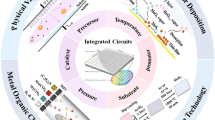Abstract
This paper presents a review of constraints, limitation factors and challenges to implement sub 1 V CMOS bandgap voltage reference (BVR) circuits in today’s and future submicron technology. Moreover, we provide insight analysis of BVR circuit architectures a designer can relay upon when building CMOS voltage reference.























Similar content being viewed by others
References
Thimoty, W. (1994). A low noise CMOS voltage reference. PhD. thesis, Georgia Institute of Technology.
Gupta, V., & Ricon-Mora, G. A. (2002). Predicting the effects of error sources in bandgap reference circuits and evaluating their design implications. IEEEs Midwest Symposium on Cricuits and Systems, 3, III-575–III-578.
Gupta, V., & Rincon-Mora, G. A. (2005). Inside the belly of the beast: A map for the wary bandgap reference designer when confronting process variation. Power Management Design Line, Feb, 503–508.
Gupta, V., & Rincon-Mora, G. A. (2005). Predicting and design for impact of process variations and mismatch on the trim range and yield of bandgap references. In IEEE International Symposium on Quality Electronic Design (pp. 503–508). California, Santa Clara.
Mok, P. K. T., & Leung, K. N. (2004). Design considerations of recent advanced low voltage low temperature coefficient CMOS bandgap voltage reference. In IEEE Custom Integrated Circuits Conference, pp. 635–642.
Abesingha, B., et al. (2002). Voltage shift in plastic-packaged bandgap references. IEEE Transactions on Circuits Systems II, 49(10), 681–685.
Jiang, Y., & Lee, E. K. F. (2000). Design of low-voltage bandgap reference using transimpedance amplifier. IEEE Transactions on Circuits Systems II, 47(6), 552–555.
Neuteboom, H., Kup, B. M. J., & Jassens, M. (1997). A DSP-based hearing instrument IC. IEEE Journal of Solid-State Circuits, 32, 1790–1806.
Banba, H., et al. (1999). A CMOS bandgap reference circuit with sub 1-V operation. IEEE Journal of Solid State Circuits, 34(5), 670–674.
Malcovati, P., et al. (2001). Curvature-compensated BiCMOS bandgap with 1-V supply voltage. IEEE Journal of Solid State Circuits, 36, 1076–1081.
Ker, M. D., Chen, J. S., & Chu, C. Y. (2005). A CMOS bandgap reference circuit for sub 1-V operation without using extra low-threshold voltage device. IEICE Transactions on Electronics, E88(11), 2150–2155.
Doyle, J., et al. (2004). A CMOS subbandgap reference circuit with 1-V power supply voltage. IEEE Journal of Solid-State Circuits, 39(1), 252–255.
Giustolisi, G., et al. (2003). A low-voltage low-power voltage reference based on subthreshold MOSFETs. IEEE Journal of Solid-State Circuits, 38(1), 151–154.
Ugajin, M., et al. (2002). A 0.6 V supply, voltage-reference circuit based on threshold-voltage summation architecture in fully depleted CMOS/SOI. IEICE Transactions on Electronics, E85-C(8), 1588–1595.
Watanabe, H., et al. (2003). CMOS voltage reference based on gate work function differences in Poli-Si controlled by conductivity type and impurity concentration. IEEE Journal of Solid-State Circuits, 38(6), 987–994.
Annema, A.-J. (1999). Low-power bandgap references featuring DTMOSTs. IEEE Journal of Solid-State Circuits, 34(7), 949–955.
Fayomi, C. J. B., Sawan, M., & Roberts, G. W. (2004). Reliable circuit techniques for low-voltage analog design in deep submicron standard CMOS: A tutorial. Analog Integrated Circuits and Signal Process, 39, 21–38.
Jiang, Y. & Lee, E. K. F. (2005). A low voltage low 1/f noise CMOS bandgap reference. In IEEE International Symposium on Circuits and systems, Vol. 4, pp. 3877–3880.
Leung, K. N., & Mok, P. K. T. (2002). A sub 1-V 15-ppm/oC CMOS bandgap voltage reference without requiring low threshold voltage device. IEEE Journal of Solid-State Circuits, 37, 526–530.
Ker, M. D., & Chen, J. S. (2006). New curvature-compensation technique for CMOS bandgap reference with sub 1-V operation. IEEE Transactions on Circuits and Systems, 53(8), 667–671.
Boni, A. (2002). Op-amps and startup circuits for CMOS bandgap references with near 1-V supply. IEEE Journal of Solid-State Circuits, 37(10), 1339–1343.
Ytterdal, T. (2003). CMOS bandgap voltage reference circuit for supply voltages down to 0.6 V. IEEE Electronics Letters, 39(20), 1427–1428.
Filanovsky, I. M., & Allam, A. (2001). Mutual compensation of mobility and threshold voltage temperature effects with applications in CMOS circuits. IEEE Transactions on Circuits and Systems I, 48(7), 876–884.
Najafizadeh, L., & Filanovsky, I. M. (2004). Towards a sub 1 V CMOS voltage reference. In IEEE International Symposium on Circuits and Systems, pp. I-53–I-56.
Huang, P. H., Lin, H., & Lin, Y. T. (2006). A simple subthreshold CMOS voltage reference circuit with channel length modulation compensation. IEEE Transactions on Circuits and Systems II, 53(53), 882–885.
Pletersek, A. (2005). A compensated bandgap voltage reference with sub 1-V supply voltage. Analog Integrated Circuits and Signal Process, 44(1), 5–15.
Luis, H. C., Ferreira, L. H. C., Pimenta, T. C., & Moren R. L. (2008). A CMOS threshold voltage reference source for very-low-voltage applications. Microelectronics Journal, 39(12), 1867–1873.
Kim, J. W., et al. (2008). Integration of bandgap reference circuits using silicon ICs and germaninum devices. In International Symposium on Quality Electronic Design (ISQED), pp. 429–432.
Acknowledgments
The authors would like to acknowledge the financial support from the Natural Sciences and Engineering Research Council of Canada (NSERC). They also wish to thank Dalton M. Colombo, Ph.D student at Federal University of Rio Grande do Sul (Porto Alegre, Brazil), and Mary-Rose Morrison for their great contributions to this work.
Author information
Authors and Affiliations
Corresponding author
Rights and permissions
About this article
Cite this article
Fayomi, C.J.B., Wirth, G.I., Achigui, H.F. et al. Sub 1 V CMOS bandgap reference design techniques: a survey. Analog Integr Circ Sig Process 62, 141–157 (2010). https://doi.org/10.1007/s10470-009-9352-4
Received:
Revised:
Accepted:
Published:
Issue Date:
DOI: https://doi.org/10.1007/s10470-009-9352-4




